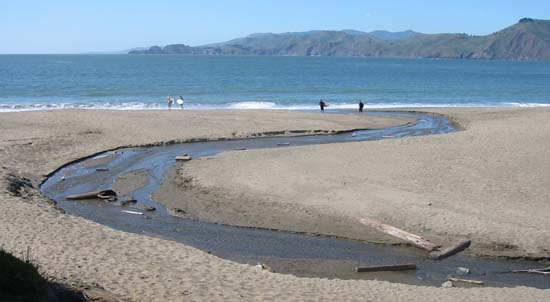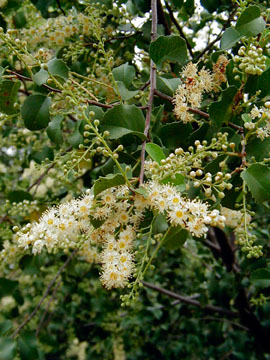Once upon a time, four creeks flowed in San Francisco, as rainfall draining from the central ridge of Twin Peaks and Mt. Davidson must return over land to its oceanic origins. But today the murmur of the eastward-flowing Mission, Islais, and Yosemite Creeks is heard no more, thanks to pavement and sewers, landfills and development. One lone open waterway remains: Lobos Creek, which winds through the southwestern Presidio and pours into the Pacific at the southern tip of Baker Beach.

Start walking from the sand dunes at the mouth of Lobos Creek, where the silvery Chamisso's lupine holds purple-blue blossoms up to the breeze, and follow the path upstream into the lush cool valley, with the tony neighborhood of Sea Cliff on your right and the Presidio on your left. An interlaced canopy of coast live oak keeps this dell covered and moist, nurturing a tangle of shade-tolerant plants under its leafy umbrella. Bracken fern, horse tail, and bee plant frolic along the banks, while nearby the robust holly-leaf cherry sports a spectacular creamy bloom. Creek dogwood and cow parsnip fight for prime position beside the water, while monkeyflowers wink in the undergrowth and man-root twists its vigorous vines around everything in sight.
Beneath it all, the burble of Lobos Creek tells a long and life-affirming tale. Water's flow from mountain to sea evokes rich and powerful images: the masculine energy of the rainstorm, the maternal lifeblood of the river, and the implications of a timeless, interpenetrating cycle.
Ecologists call this a riparian corridor, where runoff from a watershed collects into a stream; this gives rise to a distinctive water-loving plant community, as compared to those of more drought-prone regions of California. Seen from above, the riparian corridor describes a line through the landscape like a serpentine stroke of green paint brushed upon a golden-brown canvas.
San Francisco's last riparian zone, Lobos Creek runs through a pipe beneath Lincoln Blvd., south of which the creek is fenced off from the public (a dilapidated sign declares "No Trespassing: U.S. Government Water Supply"). But a recently restored coastal dune habitat alongside and above the creek (in the far southwest corner of the Presidio) features a pedestrian boardwalk, from which you can still hear the voice of the tumbling water somewhere far below.
Any Bay Area gardener with a shady yard and a heavy watering can should consider planting native selections from Lobos Creek Valley, thus to assert their kinship with the land, to encourage beneficial relationships with local wildlife, and to foster a sense of identity and pride in our disappearing heritage.
The coast live oak (Quercus agrifolia) punctuates the hills and valleys of California's Coast Ranges, forming the backbone of our riparian corridors. Not for every garden, this tree can grow 30-80 feet tall, with a stout gnarled trunk and huge spreading branches. To plant an oak is to begin a long-term relationship -- if successful, the tree will outlive your grandchildren. This is perhaps too much for those seeking instant horticultural gratification, but landscapers and native plant boosters agree that the aesthetic, ecological, and spiritual payoffs more than justify the investment.
 Other home gardeners find the holly-leaf cherry (Prunus ilicifolia) more feasible; it reaches 10-20 feet with a full body of serrate evergreen leaves and a heavy bloom of brilliant white blossoms. At Lobos Creek, it grows uphill from the banks of the stream, out of the deep shadow of the oaks -- it can tolerate more sun than many riparian specimens, but also requires excellent drainage.
Other home gardeners find the holly-leaf cherry (Prunus ilicifolia) more feasible; it reaches 10-20 feet with a full body of serrate evergreen leaves and a heavy bloom of brilliant white blossoms. At Lobos Creek, it grows uphill from the banks of the stream, out of the deep shadow of the oaks -- it can tolerate more sun than many riparian specimens, but also requires excellent drainage.
Another perennial favorite, the seep monkeyflower (Mimulus guttatus) grows in and around the creek, its yellow blossoms said to resemble the laughing faces of apes. It reaches heights between several inches and several feet, blooming prolifically between April and June. The flower's stigma (pollen receptor) actually moves when touched, curling away from any disturbance, an evolutionary trick to avoid self-fertilization by pollen-laden bees emerging from within; it also makes a fun science demonstration for children, friends, and the otherwise botanically unenlightened.
The air around Lobos Creek buzzes with bright blue dragonflies, and the careful observer occasionally can witness an egret feeding in the shallow water. The restored dunes above the creek host an erumpent population of butterflies, but alas not the exquisite Xerces Blue, last observed here in the early 1940s and now famous as the first known North American butterfly driven to extinction by human interference with its habitat.
Undeterred by the similar squelching of San Francisco's three other creeks, the lone wolf lives on; Lobos Creek Valley stands as a beacon of biological richness, and of endurance in the destructive face of "progress." Come for a visit -- where Camino Del Mar becomes Lincoln Blvd. in the Presidio near 25th Ave. -- and pay your respects to your fellow Californians, who have lived here far longer than we and our kind.
* * *
Geoffrey Coffey is the founder of Madrono landscape design studio, a principal of Bay Natives nursery, and a freelance writer for the San Francisco Chronicle.

